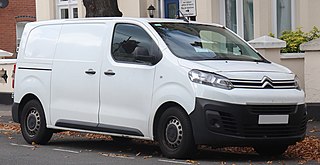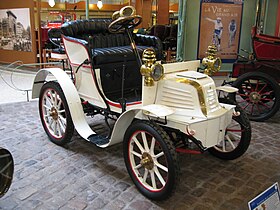
Citroën is a French automobile brand. The "Automobiles Citroën" manufacturing company was founded on 4 June 1919 by André Citroën. Citroën has been owned by Stellantis since 2021 and previously was part of the PSA Group after Peugeot acquired 89.95% share in 1976. Citroën's head office is located in the Stellantis Poissy Plant in Saint-Ouen-sur-Seine since 2021 and its offices studies and research in Vélizy-Villacoublay, Poissy (CEMR), Carrières-sous-Poissy and Sochaux-Montbéliard.

Peugeot is a French automobile brand owned by Stellantis.

Panhard was a French motor vehicle manufacturer that began as one of the first makers of automobiles. It was a manufacturer of light tactical and military vehicles. Its final incarnation, now owned by Renault Trucks Defense, was formed by the acquisition of Panhard by Auverland in 2005, and then by Renault in 2012. In 2018 Renault Trucks Defense, ACMAT and Panhard combined under a single brand, Arquus.

The Peugeot 504 is a mid-size, front-engine, rear-wheel-drive automobile manufactured and marketed by Peugeot from 1968 to 1983 over a single generation, primarily in four-door sedan and wagon configurations – but also as twin two-door coupé and cabriolet configurations as well as pickup truck variants.

The Citroën BX is a large family car which was produced by the French manufacturer Citroën from 1982 to 1994. In total, 2,315,739 BXs were built during its 12-year history. The hatchback was discontinued in 1993 with the arrival of the Xantia, but the estate continued for another year. The BX was designed to be lightweight, using particularly few body parts, including many made from plastics.

The Peugeot 104 is a supermini car produced by the French company Peugeot between 1972 and 1988. It was designed by Paolo Martin was initially only sold as a four-door saloon car, with a three-door hatchback variant introduced in 1974 and a five-door hatchback version replacing the saloon in 1976. The 104 was the first model produced at the company's Mulhouse plant. It was also the first new Peugeot introduced since 1955 not to be offered in a diesel version.

The Peugeot 206 is a supermini car (B-segment) designed and produced by the French car manufacturer Peugeot since May 1998 as a replacement to the Peugeot 205. Developed under the codename T1, it was released in September 1998 in hatchback form, which was followed by coupé cabriolet in September 2000, station wagon in September 2001, and a sedan version which is an abbreviation of the Iranian and Persian word sandogh-dar, it was made, produced and sold in Iran. in September 2005, before being replaced by the 207 in April 2006.

The Citroën Jumpy is a light commercial van jointly developed by FCA Italy and PSA Group, and mainly manufactured by Sevel, a joint venture between the two companies since 1994. The Jumpy was also sold as the Peugeot Expert and Fiat Scudo beginning in 1995.

The Peugeot 305 is a medium-sized car produced by the French automaker Peugeot from 1977 to 1989. It was offered as a four-door saloon, five-door estate, and as a three-door van derivative.

The Peugeot 208 is a subcompact car produced by the French automaker Peugeot. Unveiled at the Geneva Motor Show in March 2012 and positioned below the larger 308, the 208 replaced the 207 in 2012, and is currently at its second generation.

The Peugeot 2008 is a subcompact crossover SUV (B-segment) produced by the French automaker Peugeot. Unveiled at the 2013 Geneva Motor Show and positioned below the 3008, the first 2008 replaced the Peugeot 207 SW, as Peugeot did not release an SW version of its 208.

The Peugeot Type 183 was a 2-litre six cylinder car produced between 1927 and 1931 by the French auto-maker Peugeot at their Audincourt plant. It was first exhibited at the Paris Motor Show in 1927, but cars only became available for sale in 1928.

The Peugeot Type 156 was a large car announced in 1920 and produced between 1921 and 1923 by the French auto-maker Peugeot at their Sochaux plant. It was Peugeot’s first large car since before the First World War and its arrival recalled the Peugeot Type 135 which had ceased production in 1913. However, the 156 was larger and more powerful.

The Peugeot Type 2 is the first petrol/gasoline-powered motor vehicle produced between 1890 and 1891 by the French auto-maker Peugeot at their Valentigney plant. The car was presented just two years after Armand Peugeot had split away from the Peugeot family business in order to concentrate on cars, with a separate Peugeot Automobiles business.
France was a pioneer in the automotive industry and is the 11th-largest automobile manufacturer in the world by 2015 unit production and the third-largest in Europe. It had consistently been the 4th-largest from the end of World War II up to 2000. It is 16% of sales of French manufactured products.
The Stellantis Sochaux Plant is one of the principal car plants in France - in 2007 approximately 326,000 cars were produced there, and as of May 2011 the staff numbered 11,972 permanent workers, approximately 2,000 temporary workers, as well as over 800 employees from other companies working at the Sochaux plant. The plant was created by Peugeot in 1912, initially as a truck factory, but by the 1930s it had become the company's principal car manufacturing plant, and the main production site for all principal Peugeot models from then until 1972, when the company established a second major French car assembly plant in Mulhouse.
Rétrospectives Automobiles Miniatures was a French manufacturing company that made diecast scale model collector vehicles mostly of classic French automobiles in 1:43 scale. The acronym was seen on packaging without the periods between the letters of the acronym, but on some of the vehicle bases with the punctuation. "J.M.K." was a further acronym that stood for the three founding members of the company: M. Jarry, Henri Malartre and M. Koch. Though the models were often known simply as RAMI, the full name of the company was RAMI by J.M.K.
Paul-Marie Pons was a French naval engineer who became a senior civil servant. He is remembered for the Pons Plan which restructured the French automotive industry in the second half of the 1940s.

The Citroën B10 is an automobile produced by Citroën at André Citroën's factory in central Paris between 1924 and 1925.















